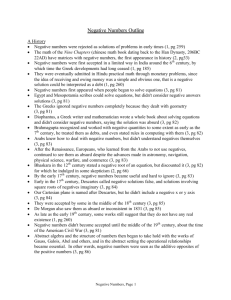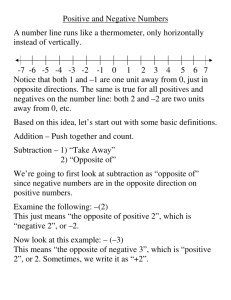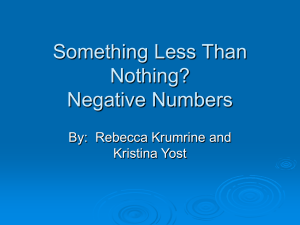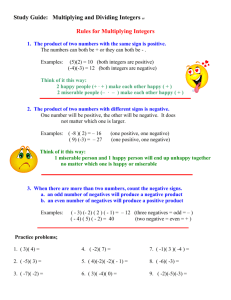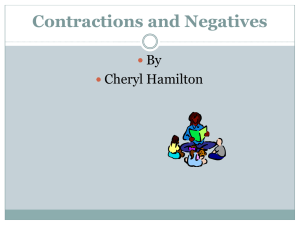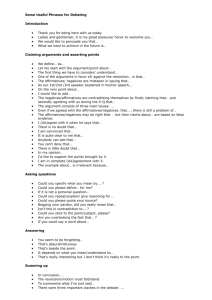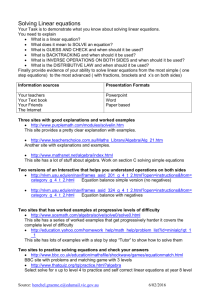The Negative - My Webspace files
advertisement
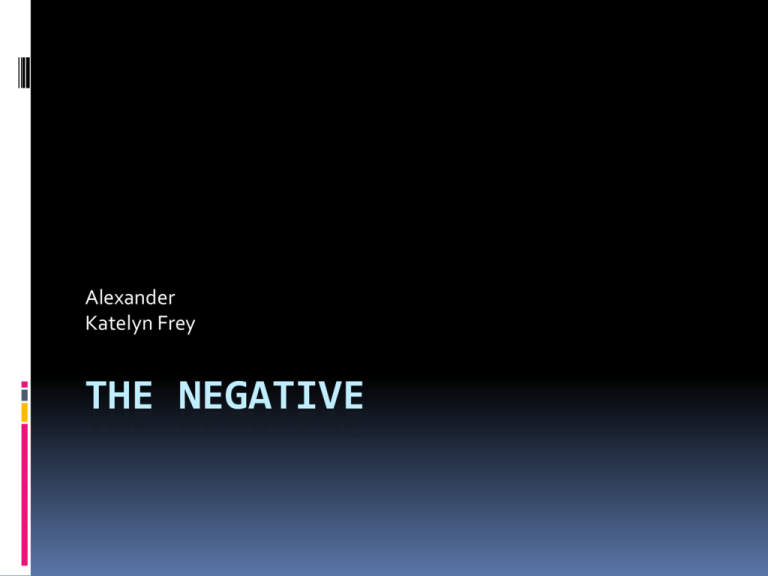
Alexander Katelyn Frey THE NEGATIVE Negatives not accepted until a few hundred years ago Columbus discovered America nearly two centuries before negatives were considered numbers Negatives were accepted around the middle of the 19th century , about the time of the American Civil War NUMBERS AROSE FROM COUNTING THINGS 5 Goats 2 Pigs 12 Coins 4 Bottles of Milk 7 Apples FRACTIONS REPRESENTED SMALLER UNITS ½ a loaf of bread 5/8 inch 3/10 of a mile So if your counting and measuring, Zero must be the smallest possible quantity ? After all, how can any quantity be less than nothing ? Negatives first appeared on the scene when people began solving equations. For example : “I am seven years old and my sister is 2. When will I be exactly twice as old as my sister ?” 7 + x = 2 (2+x) x – number of years from now Answer : 3 years from now What is the solution to the following: 18 + x = 2 (11 + x) 18 + x = 22 + 2x -22 –x -22 -x -4 = x Scribes in Egypt and Mesopotamia could solve these equations more than 3,000 years ago, but they never considered the possibility of negative solutions. The Chinese mathematics were able to understand and handle negative numbers. The Greeks, who mostly influenced Western culture ignored negative numbers Thought of “numbers” as positive whole numbers And that line segments, areas, and volumes were different kinds of magnitudes. (and therefore not numbers) Wrote Arithmetica, a book on solving equations, which lead him to this equation: 4x + 20 = 4 “This is absurd, because 4 is smaller than 20.” To Diophantus, 4x + 20 meant adding something to 20, and hence could never be equal to 4. Diophantus BRAHMAGUPTA Indian mathematician Worked with negatives in the 7th century Treated positive numbers as possessions And negative numbers as debts Also created rules for adding, subtracting, multiplying and dividing negatives Bhaskara 5 centuries after Brahmagupta Stated that the two roots of the equation : x² - 45x = 250 Are x = 50 and x = -5 However, he said that -5 was not to be taken seriously because of its inapplicability and because people had no clear understanding of negative quantities. Arab Mathematics Did not use negative numbers partly because they did not use symbols to solve algebraic equations. They only used words with geometric interpretations of all numerical data as segments or areas. Al-Khwarizmi recognized the quadratic equation can have two roots but only if they were positive. In part, because he used the side lengths of rectangles to solve these, which is a case where negatives make no sense. Negative Numbers in China The Chinese could handle negative numbers. Negative numbers appeared for the first time in China’s Nine Chapters in the period of the Han Dynasty (202 B.C.- 220 A.D.). Credited with being the first to recognize and use negative numbers. Used a symbol for negative numbers. European Mathematics European mathematicians only learned positive numbers from their predecessors. Negative numbers were still seen as “absurd” or “fictitious.” Fibonacci’s book Liber Abaci contained problems with negative solutions, interpreted as debts (13th century). Cardano’s Ars Magna included negative solutions of equations and also had basic laws of operating with negative numbers (16th century). Used m: as a negative sign. Ex: m:2 = -2. COMPLICATIONS IN THE 17TH CENTURY. Negative numbers began to be used in the European’s work. Solutions of quadratic equations. Rene Descartes Antoine Arnauld (1612-1694) John Wallis (1616-1703) Arithmetica Infinitorum (1655), argued that negative numbers were greater than infinity. Invented the number line, which gave meaning to negative numbers, allowing them to be thought of in terms of direction. Isaac Newton’s Universal Arithmetick Can you justify Euler’s claim that –a times –b should be the opposite of a times –b. What does opposite mean in this context? How does part (a) imply that the product of two negative numbers must be positive? How should a times –b be related to –a times b? Why? Acceptance in the th 18 Century Negatives were accepted as numbers. Leonhard Euler (1707-1783) Controversy Leibniz, Johann Benoulli, Euler, and d’Alembert argued about whether log(-x) was the same as log(x). • Maclaurin Treated negative numbers on the same level as positive numbers in his A Treatise of Algebra in Three Parts. Discussion Discuss among the class the reasoning leading to Wallis’s claim that “If negative numbers are less than zero, then they must be greater than infinity.” How would you have reacted to Wallis’s argument? 19TH CENTURY Gauss Galois Abel And others 5th century – 3rd century B.C.E. Greece 100 B.C.E – 50 A.D. China No indication of negative numbers Negative numbers appeared in Nine Chapters. 3rd century A.D. Greece Diophantus’s Arithmetica referred to negative numbers as absurd. 7th century A.D. India Negative numbers were used to represent debts. 9th – 12th centuries A.D. Arabia Arabs learned of negatives from Indian mathematicians, but rejected the use of negatives. Abul-Wafa (10th century) used negatives to represent debt. Al-Samawal (12th century) stated rules for addition, subtraction, and multiplication of negatives. 12th century A.D. India Bhaskara gave roots for quadratic equations, but said the values were not to be accepted. 13th century A.D. China and Italy China- Negative numbers were denoted by a symbol (diagonal stroke). Italy- Fibonacci’s book Liber Abaci contains problems that have negative solutions, interpreted as debts. 15th century A.D. Europe 16th century A.D. Europe Wallis accepted negative numbers, but argued they were larger than infinity. 18th century A.D. Europe Cardano’s Ars Magna had negative solutions to equations, also used a symbol (m: ) to denote a negative number. 17th century A.D. Europe Chuquet was the first to use negative numbers as exponents in Europe, referred to them as absurd. Maclaurin treated negative numbers on the same level as positive numbers in his A Treatise of Algebra in Three Parts. 19th century A.D. Mathematicians Gauss, Galois, Abel, and others focused on a more abstract setting of mathematics, where negatives numbers had use. Doubts of negative numbers disappeared. Sources Mcdougal, . & Littell, . Retrieved 09. 07, 2009. Web site: http://www.classzone.com/books/algebra_1/page_build.cfm?content=links_app3_ch 2&ch=2. (2009). Negative and Non-Negative Numbers. Retrieved 09. 07, 2009, from Wikipedia. Web site: http://en.wikipedia.org/wiki/Negative_and_nonnegative_numbers#History. Rogers, L. (2008). The History of Negative Numbers. Retrieved 09. 07, 2009, from NRICH, University of Cambridge. Web site: http://nrich.maths.org/public/viewer.php?obj_id=5961. Smith, M. K. Retrieved 09. 07, 2009. Web site: http://www.ma.utexas.edu/users/mks/326K/Negnos.html Howard, J. (2009). Negative Numbers. Retrieved 09. 07, 2009, from NRICH, University of Cambridge. Web site: http://www.ma.utexas.edu/users/mks/326K/Negnos.html. Berlinghoff, W. P. & Gouvea, F. Q. (2004). Something Less Than Nothing? Negative Numbers. In Z. A. Karian (Ed.), Math Through the Ages (pp. 93-100). Farmington, Maine: Oxton House Publishers. http://en.wikipedia.org/wiki/Negative_and_non-negative_numbers http://en.wikipedia.org/wiki/Number
